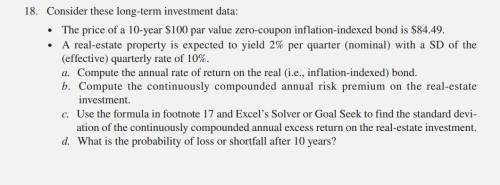
Business, 17.09.2021 14:00 nallaico585
Consider these long-term investment data:
∙ The price of a 10-year $100 par value zero-coupon inflation-indexed bond is $84.49.
∙ A real-estate property is expected to yield 2% per quarter (nominal) with a SD of the
(effective) quarterly rate of 10%.
a. Compute the annual rate of return on the real (i. e., inflation-indexed) bond.
b. Compute the continuously compounded annual risk premium on the real-estate
investment.
c. Use the formula in footnote 17 and Excel’s Solver or Goal Seek to find the standard deviation of the continuously compounded annual excess return on the real-estate investment.
d. What is the probability of loss or shortfall after 10 years?


Answers: 2


Another question on Business


Business, 21.06.2019 18:30
What is the communication process? why isnt it possible to communicate without using all the elements in the communication process?
Answers: 3

Business, 21.06.2019 21:00
Which of the following statements is correct? a) due to limited liability, unlimited lives, and ease of ownership transfer, the vast majority of u.s. businesses (in terms of number of businesses) are organized as corporationsb) most businesses (by number and total dollar sales) are organized as proprietorships or corporation. however, if the business gets very large, it becomes advantageous to convert to a corporation, primarily because corporations have important tax advantages over proprietorships and partnerships.c) due to legal considerations related to ownership transfers and limited liability, which affect the ability to attract capital, most business (measured by dollar sales) is conducted by corporations in spite of large corporations' less favorable tax treatmentd) large corporations are taxed more favorably than proprietorshipse) corporate stockholders are exposed to unlimited liability
Answers: 2

Business, 21.06.2019 22:20
Amachine purchased three years ago for $720,000 has a current book value using straight-line depreciation of $400,000: its operating expenses are $60,000 per year. a replacement machine would cost $480,000, have a useful life of nine years, and would require $26,000 per year in operating expenses. it has an expected salvage value of $130,000 after nine years. the current disposal value of the old machine is $170,000: if it is kept 9 more years, its residual value would be $20,000. calculate the total costs in keeping the old machine and purchase a new machine. should the old machine be replaced?
Answers: 2
You know the right answer?
Consider these long-term investment data:
∙ The price of a 10-year $100 par value zero-coupon infl...
Questions


English, 29.07.2019 17:30


Chemistry, 29.07.2019 17:30





Social Studies, 29.07.2019 17:30




History, 29.07.2019 17:30




Social Studies, 29.07.2019 17:30


Biology, 29.07.2019 17:30




